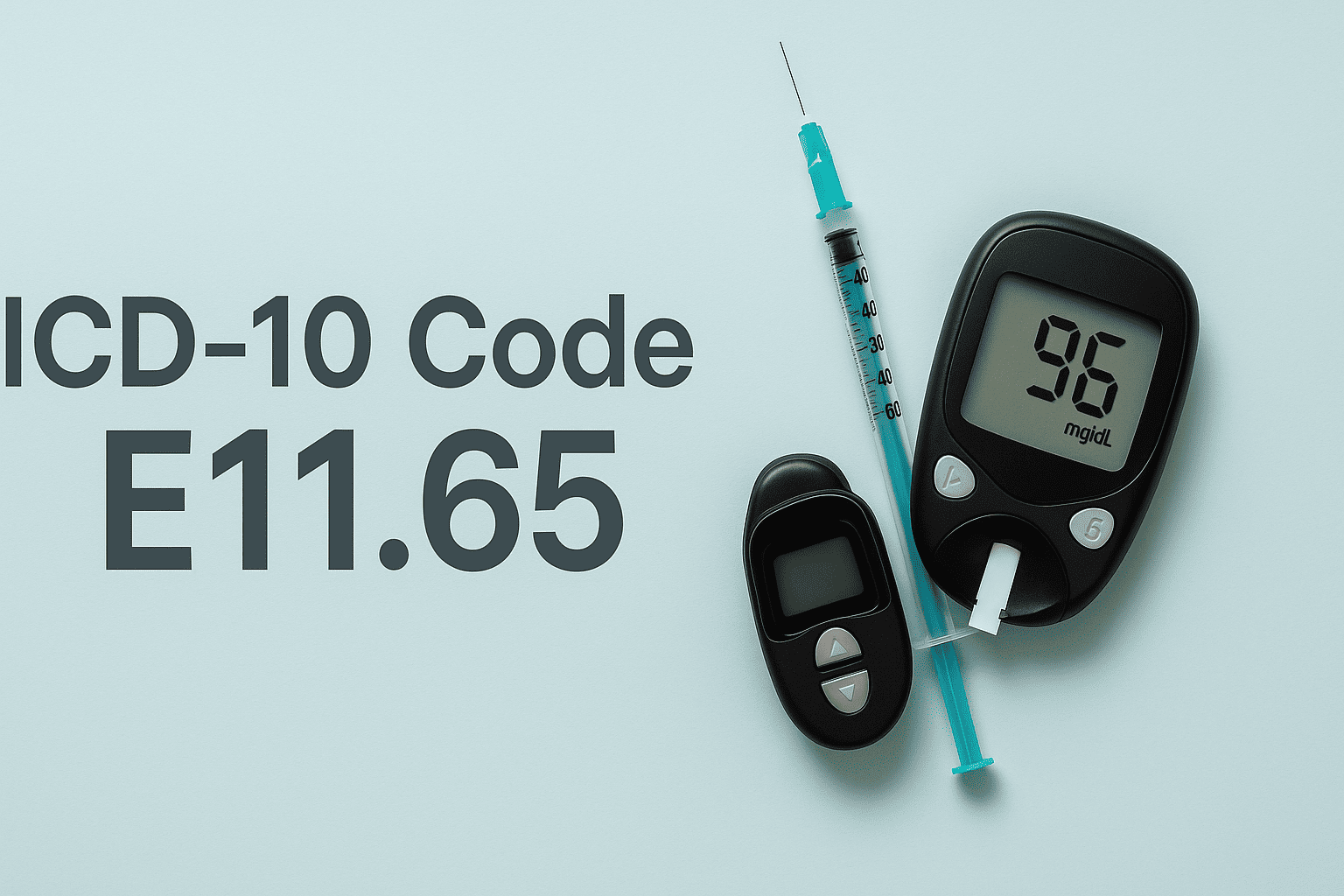Updated on: July 29, 2025
Hyperglycemia is a common and dangerous complication of Type 2 Diabetes Mellitus (T2DM). Unlike uncomplicated diabetes (E11.9), patients coded with E11.65 are experiencing uncontrolled elevated blood glucose levels—either due to noncompliance, missed doses, incorrect dosing, or progressive disease.
This article provides clinicians with a comprehensive guide to using ICD-10 code E11.65 effectively. We’ll cover clinical scenarios, documentation tips, management strategies, and pitfalls to avoid when coding hyperglycemia in diabetic patients.
What Is ICD-10 Code E11.65?
E11.65 is used when:
-
The patient has Type 2 diabetes
-
Hyperglycemia is present and documented
-
The elevated glucose is not life-threatening (i.e., not DKA or HHS)
-
There is no acute complication like coma or acidosis
This code indicates poor glycemic control, either due to lifestyle, medication adherence, or progression of disease.
E11.65 vs. Related Diabetes Codes
| ICD-10 Code | When to Use |
|---|---|
| E11.9 | T2DM with no complications or symptoms |
| E11.65 | T2DM with hyperglycemia, but no crisis |
| E11.00 | T2DM with ketoacidosis, without coma |
| E11.10 | T2DM with ketoacidosis, with coma |
| E11.69 | T2DM with other specified complications |
Clinical Scenarios That Warrant E11.65
| Patient Presentation | Code to Use |
|---|---|
| A1c 10.8%, random glucose 295 mg/dL; no DKA or hospitalization | E11.65 |
| Missed medications for a week, now experiencing hyperglycemia | E11.65 |
| Asymptomatic but persistent fasting glucose > 180 mg/dL | E11.65 |
| Polyuria, fatigue, A1c 9.5% | E11.65 |
| Glucose 130, A1c 6.8%, stable on meds | E11.9 |
| Patient in DKA or HHS | E11.00 / E11.01 |
Documentation Guidelines for E11.65
To justify using E11.65:
-
Include glucose values (random, fasting, postprandial)
-
Mention A1c level
-
Document hyperglycemia symptoms if present (fatigue, polydipsia, polyuria, blurred vision)
-
Clearly state “uncontrolled diabetes” or “hyperglycemia due to diabetes”
-
Note medication changes or lifestyle counseling
Example Chart Note:
“Patient with known T2DM, missed insulin doses over past week. Reports fatigue and blurry vision. Glucose in office 285 mg/dL. A1c from last month was 9.8%. Diagnosis: Type 2 diabetes with hyperglycemia (E11.65). Restart insulin regimen and follow-up in 1 week.”
SOAP Note Example – E11.65
-
S: “Feeling tired, frequent urination and blurry vision”
-
O: BP 130/78, glucose 275 mg/dL, A1c 10.2%
-
A: Type 2 diabetes with hyperglycemia (E11.65)
-
P: Increase insulin glargine to 30 units QHS, reinforce dietary compliance, repeat labs in 10 days
Hyperglycemia Symptoms to Include
| Common Symptoms | Optional Documentation |
|---|---|
| Fatigue | “Patient complains of tiredness” |
| Polyuria | “Reports frequent urination” |
| Polydipsia | “Increased thirst” |
| Blurred vision | “Trouble seeing clearly” |
| Unintentional weight loss | “Lost 5 lbs over the past 2 weeks” |
Medication Strategies for E11.65
| Scenario | Medication Changes |
|---|---|
| A1c > 9.0%, patient on oral agents only | Consider adding basal insulin |
| Missed doses of oral meds | Reinforce adherence; evaluate barriers |
| Overweight with poor control | Add GLP-1 receptor agonist or SGLT2 inhibitor |
| Elderly with hypoglycemia risk | Titrate carefully; avoid sulfonylureas |
Related Codes Often Used With E11.65
| Clinical Detail | ICD-10 Code |
|---|---|
| Long-term insulin use | Z79.4 |
| Long-term oral hypoglycemic use | Z79.84 |
| Obesity | E66.9 |
| Noncompliance with medications | Z91.14 |
| Diabetic education provided | Z71.89 |
Coding Tips & Common Mistakes
| Error | Correction |
|---|---|
| Using E11.9 when A1c is >9% or glucose >250 | Use E11.65 for poor glycemic control |
| Forgetting to document lab values | Always document A1c/glucose for validation |
| Missing lifestyle or med plan | Add treatment modifications or counseling |
| Using E11.00 (DKA) when no acidosis present | Only use DKA code if criteria are met |
FAQs
Can I use E11.65 even if the patient has no symptoms?
Yes—if labs show significant hyperglycemia (e.g., A1c > 9%, glucose > 250 mg/dL), even without symptoms, E11.65 is appropriate.
What if the patient is hospitalized?
If hyperglycemia is severe or leading to DKA/HHS, consider codes E11.00 or E11.01, based on severity.
Can E11.65 be used for telehealth visits?
Yes—especially if patients report symptoms or home glucose readings indicating poor control.
How DocScrib Helps Code & Document E11.65 Accurately
With DocScrib, clinicians get:
✅ Instant detection of hyperglycemia indicators (A1c, glucose)
✅ Auto-suggestions for E11.65 when poor control is detected
✅ Built-in prompts for treatment changes, patient counseling, and follow-up
✅ Support for preventive care, diabetic education, and medication adherence notes
🎯 Book your free DocScrib demo today to enhance your diabetes documentation and billing compliance.
Conclusion
ICD-10 Code E11.65 – Type 2 Diabetes with Hyperglycemia is essential for accurately reflecting poorly controlled blood glucose. This code ensures proper risk adjustment, audit protection, and clinical care planning. Whether it’s missed medications, suboptimal regimens, or lifestyle factors, DocScrib helps capture and code these details—seamlessly and accurately.
